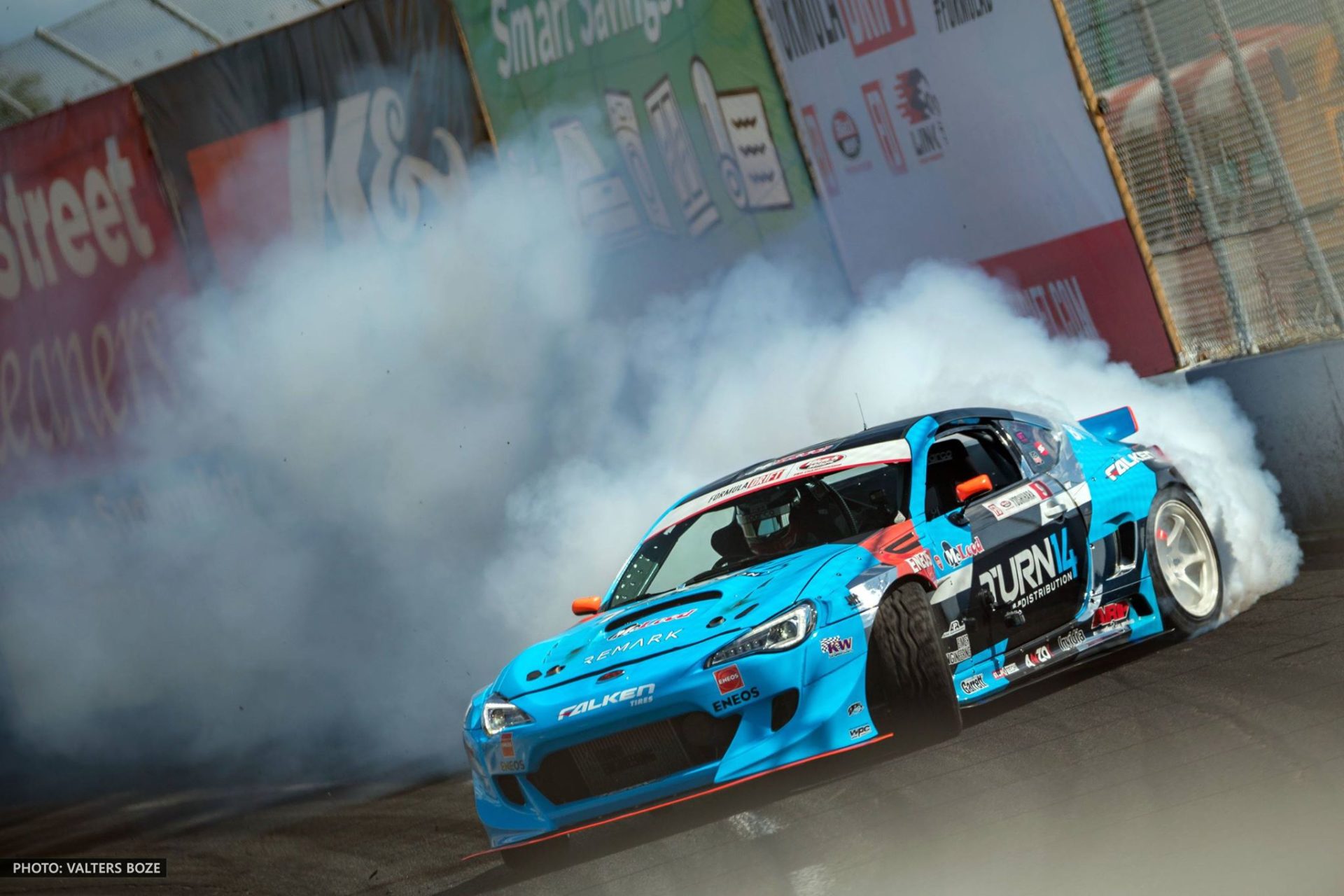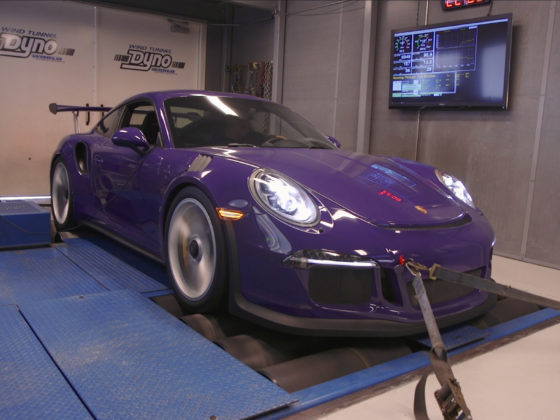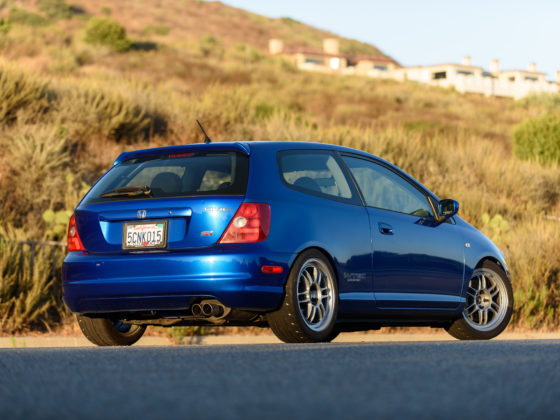
Our new Stoptech AeroRotor was 35 mm thick and had much more venting than our previous rotors did. The venting in the AeroRotor is CFD optimized to flow the maximum amount of cooling air. Stoptech had calculated that the rotors modest 328mm diameter was enough for our application. These are our front rotors after a whole season of FD competition! With the Stoptech system, our brake wear went from pretty severe to almost non-existent. Perhaps we can now go at least a couple of seasons on one set of brakes vs about two events! The improvement in wear is just that dramatic.

The Stoptech AeroRotors are a light weight two-piece design and have hard anodized hats machined from 7075-T6 aluminum. The hats are free floated to prevent distortion under heat and to eliminate caliper pad knockback if we have any knuckle or bearing system flex or freeplay. Since this is a race application the rotor bolts do not have anti-rattle washers like the street versions of these rotors do leaving the friction ring completely free to float on the hat.
As you can see here, the AeroRotor hats are vaned and vented allowing cooling air to freely pass between the rotor friction ring and the hat. This helps keep heat out of the hubs bearing system and will also help to reduce friction ring temperature.
The calipers are bolted to the front knuckle using a 7075-T6 CNC machined radial mount bracket from maximum stiffness. We had relocated the bracket all the way to the side of the rotor with our custom knuckle to reduce the effects of knockback to the minimum already.

In the rear, the rear brakes were upgraded with larger STR-40 calipers. The STR-40 calipers have all the same features as the front calipers and were sized to have the exact same piston area as our previous system for compatibility with our current pedal box, master cylinders, and balance bar. The race STR calipers do not have dust boots as the street versions do to prevent the issue of the dust boots possibly burning up with hard use.

The rear calipers were held in place with custom radial mount brackets machined of7075-T6 aluminum. This was necessary as the cars custom rear knuckles were originally designed to use ear mounted calipers.




12 comments
What is the purpose of the cross drilled rotor with integrated slots from the drilled hole? Does it prevent cracking from thermal expansion?
I looked all over Wilwood’s website but couldn’t find those particular rotors.
Its mostly to vent the pad outgassing. It actually makes the rotor more prone to cracking and isn’t done much anymore.
Those are thermal expansion slots, which certainly would have been to extend the time before cracking started. When iron rings heat up to competition temperatures, the expansion must be planned for. If not, then iron will crack sooner (beyond the normal “crazing”). There are better ways to deal with this, yet the sprint car/dirt track market typically operate on tight budgets,, so this would be one way to get there.
On the one hand it seems funny that Stoptech keeps coming up… but they really are at kind of a sweet spot. I know from pricing stuff up what a quantum leap up it is to go to the next tier of brakes, and I’m not sure, say, an Alcon TA6 (same pad shape too, I think) is more than incremental gains for the 4x (or so) price jump. I like that some of the newer calipers they’re doing are using more common racing pad shapes than the Brembo shapes the 40 calipers use.
I really like StopTech because they have the tremendous range of piston sizes which enables them to match OEM proportioning. People don’t realize how critical this is and how it affects a car’s electronics nowadays and if the car is an older car, how it affects pedal feel and balance. That’s not the case in this car because it is a race car with a pedal box but for cars with a single master cylinder, it’s amazingly good.
For their street kits, Stoptech also has rigorous validation testing. to assure the vehicle dynamics are safe. When developing frictions and caliper systems, they have OEM level brake dynos and do extensive validation that way as well. They also have a PHD tribologist and develop their own frictions in-house.
Sure Brembo and AP have some more advanced calipers but those are not the ones people typically use for street and grassroots applications. Those are no better than StopTech. StopTech’s engineering office is right down the street from us and they are very generous with help and technical support.
Brembo or AP’s engineering department would probably roll their eyes at the thought of working with a drift Team or not even have any knowledge that drifting has advanced to a high-level motorsport.
Yeah; I have to respect the niche that Stoptech has carved out for themselves. It was a little funny because until I looked it up I didn’t realize the STR60 was using as big of a pad as it is; I like that and a lot of their recent design decisions, and that’s leaving aside the validation they do.
I look at it sort of like… yeah, you end up using Stoptech in a lot of builds. But I know walking pits and looking at prototypes and GT cars and stuff in the 90s to recently (there’s more good options now but you know what I mean) basically everything would have Penske shocks… well, sometimes there is just a “best” solution given constraints.
The pad surface area doesn’t change braking performance, just pad life.
It looks like that kit was a little over engineered for this setup – you could have gone lighter and replaced twice per season? It just depends how much different rotational weight/inertia makes to chassis and tyre dynamics. And team budget of course!
We didn’t just throw some stuff on the car, I worked with StopTech’s engineering department to come up with a system that would solve our problems and improve our brake performance. Pad area doesn’t change the amount of brake torque produced but it can greatly affect the fade characteristics of the brake besides just affecting wear! The system is not overbuilt, it is sized correctly to take the thermal loading that the car produces. With our previous system, we had to run a very high mu aggressive pad with a narrow effective temperature range. Brake temperatures were sky high, the rotors would glow red hot and wear was extreme. Consistency was also an issue due to the pads narrow temperature operating range. Overall performance was adequate. Our new system is only 1.5 lbs per corner heavier in the front and 1 lb per corner in the rear. We are running a 335mm low mass front rotor, not the internally thicker and heavier high thermal capacity rotor. To reduce the capacity would run the thinner rotor, you would only be saving weight with the vane thickness not by reducing material in the friction surface, not worth it in my book.
Great answer Mike – I love your articles. Keep it up!
@Mike Kojima – how important is lightweight brakes (unsprung weight) and small discs (low inertia) for drifting suspension and chassis setup?
Well, you have to have enough brake to do the job, and too much is just weight in a bad place. Having enough brake is the most important thing.
Great answer Mike – I love your articles. Keep it up!